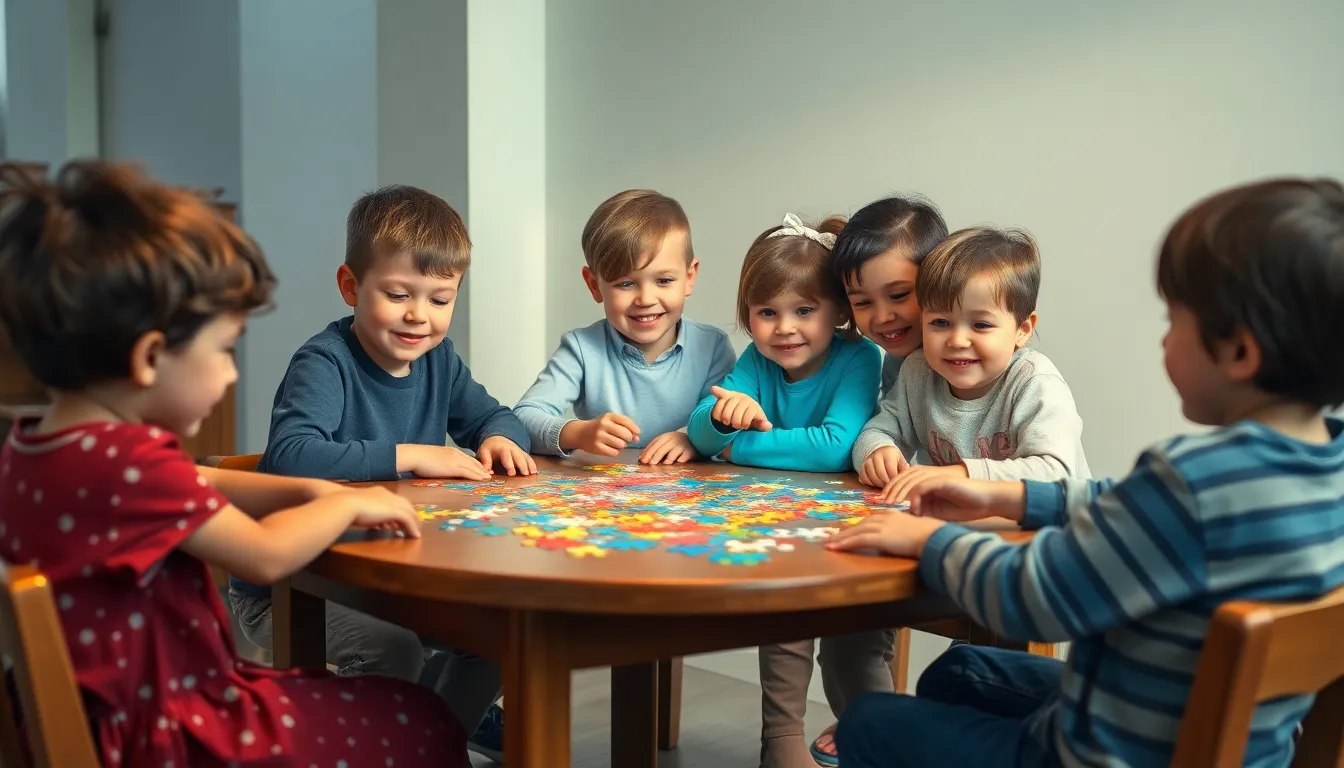Table of Contents
ToggleIn a world buzzing with energy, finding moments of peace can feel like searching for a unicorn. But fear not! Quiet games for children are here to save the day, transforming chaos into calm with a sprinkle of creativity. These games not only keep kids entertained but also give parents a much-needed breather. Who knew silence could be so golden?
Imagine a room filled with giggles instead of shouts, where kids engage in imaginative play without the need for a referee. Quiet games encourage focus, foster social skills, and even spark a little friendly competition—all while keeping the volume dialed down. So, if you’re ready to swap the raucous for the serene, dive into the world of quiet games and discover how fun can thrive in tranquility.
What Are Quiet Games for Children?
Quiet games for children are activities designed to foster calm engagement and imagination. These games often involve minimal noise, allowing kids to focus and enjoy their surroundings without distractions. Examples include puzzles, card games, and storytelling sessions, which encourage creativity while promoting social interaction.
Such games enhance concentration and mindfulness. Playing quietly helps children develop patience and cooperation as they engage in shared activities. Board games, for instance, instill strategic thinking and teamwork while remaining low-key.
Additionally, quiet games can serve as valuable tools for developing fine motor skills. Activities like coloring or crafting require dexterity and attention to detail, providing unique learning opportunities. Meanwhile, storytelling promotes language skills and stimulates imagination through creative narratives.
Importantly, quiet games help parents and caregivers enjoy moments of tranquility. These activities can transform a noisy environment into a peaceful space, offering an effective solution for daily chaos. Families can set aside specific times for quiet play, reinforcing a routine that values calmness.
Quiet games for children embody both entertainment and developmental benefits. They create serene environments while supporting a child’s growth in various areas. By incorporating these activities, families can establish a balance between lively play and the need for calm, enriching children’s playtime experience.
Benefits of Quiet Games

Quiet games offer numerous advantages for children, promoting calmness and focus in their play. These activities create a peaceful atmosphere while supporting cognitive and social development.
Enhancing Focus and Concentration
Engaging in quiet games helps children improve their focus. Activities such as puzzles and board games require sustained attention, allowing kids to practice concentration. As they engage, children learn to filter distractions, honing their ability to focus in various settings. Quiet games also encourage mindfulness, enabling kids to connect with their tasks more deeply. Enhanced concentration during play translates to improved performance in academic settings. Research shows that children who spend time in quiet, focused play demonstrate better attention spans and increased task completion rates.
Encouraging Creativity
Quiet games serve as outlets for creativity. Storytelling activities encourage children to use their imaginations, constructing elaborate narratives. Art projects foster self-expression, allowing kids to explore various media like crayons, paints, and clay. Through these activities, children can experiment with innovative ideas without the stress of competitive environments. Additionally, imaginative play develops problem-solving skills, as kids navigate challenges within their stories or projects. A study indicated that children who engage in creative play show enhanced cognitive flexibility, which benefits academic learning and social interactions.
Types of Quiet Games
Quiet games come in various forms, catering to different environments and preferences. These games provide engaging ways for children to focus while fostering creativity.
Indoor Quiet Games
Indoor quiet games offer opportunities for kids to engage without causing disruption. Puzzles and board games top the list, promoting problem-solving and teamwork. Card games like Uno or Go Fish enhance social interactions and strategic thinking. Imaginary play with dolls or action figures encourages storytelling and creativity. Additionally, art activities such as coloring, painting, and crafting develop fine motor skills while allowing self-expression.
Outdoor Quiet Games
Outdoor quiet games can be just as entertaining and beneficial. Nature scavenger hunts invite kids to explore their surroundings, observing details in the environment. Quiet games such as I Spy develop observation skills and encourage communication among players. Another option includes simple activities like drawing with sidewalk chalk, combining creativity with outdoor fun. Additionally, reading or storytelling sessions in a park provide a serene backdrop for developing language skills and enhancing imagination.
Tips for Implementing Quiet Games
Creating the right atmosphere enhances the effectiveness of quiet games. Thoughtfully arranging the space promotes serenity and engagement.
Setting Up the Environment
Arrange quiet spaces with comfort and minimal distractions. Use soft lighting and cozy seating to create a calming vibe. Place toys and games within easy reach, ensuring children can access materials independently. Designate specific areas for different activities, separating spaces for puzzles, arts, and storytelling. Noise-canceling headphones may also assist in blocking out background sounds. Parents and caregivers should minimize clutter, allowing kids to focus entirely on the task at hand.
Involving Different Age Groups
Choose games that cater to various developmental stages. Select simple puzzles for younger children while offering more complex board games for older siblings. Setting family game nights can foster inclusivity, where everyone participates regardless of age. Tailoring storytelling themes to match children’s interests enhances engagement. Encourage collaboration by forming small mixed-age groups, promoting teamwork and social skills. Adapt existing games to accommodate different skill levels, ensuring all kids find enjoyment in quiet play.
Quiet games offer a unique blend of entertainment and developmental benefits for children. They create peaceful environments that allow kids to explore their creativity while enhancing focus and social skills. By incorporating these activities into daily routines, families can enjoy moments of tranquility and foster deeper connections through shared play.
Whether it’s through puzzles, storytelling, or outdoor exploration, quiet games encourage children to engage in imaginative and mindful experiences. Embracing these activities not only enriches playtime but also supports essential skills that benefit children’s growth and learning. Families can cultivate a balanced atmosphere that nurtures both lively interactions and serene moments, making quiet games an invaluable addition to any household.




